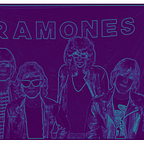Punk in the Pixels — Naturally comparing rock bands with edge detection algorithms. [With Code]
Livin’ on the Edge — I’m pretty sure Steven Tyler was singing about edge detection.
In computer vision, edge detection is the rockstar sandwiched somewhere between Mick Jagger and Jerry Lee Lewis in the Rock and Roll Hall of Fame. Although one could argue Elvis is the King, edge detection is the backbone for tasks like object recognition, segmentation, and motion tracking. In the arsenal of edge detection algorithms, there are three that reign undefeated: Canny, Sobel, and Deep Neural Networks (DNNs). Like AC/DC, Led Zeppelin, and the Rolling Stones, each algorithm has its strengths and weaknesses.
Let’s head to the stage and witness the edge-detecting battle of the bands!
Canny Edge Detection ~ Radiohead — layered soundscapes and attention to detail:
Arguably the best Radiohead song of all time, “Paranoid Android” is 6 minutes of textured rock greatness.
We weave through jazzy piano interludes, crunchy alt-rock riffs, and orchestral swells, each section a different shade of Radiohead’s sonic palette. Canny edge detection embodies this precision, employing a multi-stage process to unearth the true contours of objects, much like a Jonny Greenwood guitar solo. These are the steps to build a Canny masterpiece.
- Smoothing the Scene: First, Canny casts a calming fog over the image, blurring details and filtering out noise. This clears away distractions to ensure precise analysis of the underlying structure.
- Glimmer of the Gradient: Beneath the smoothed surface, Canny seeks sharp changes in intensity — the telltale clues of object boundaries. It uses masks to calculate the image’s gradient, pinpointing areas where pixel values transition rapidly.
- Thinning the Lines: Not all gradients are created equal. Canny ruthlessly eliminates weak ones, preserving only the strongest pixels along their direction. This non-maximum suppression results in thin, precise edges.
- Connecting the Dots: But precise edges aren’t enough. Canny seeks continuity, building bridges between strong pixels using two thresholds. The lower threshold acts as a whisper, allowing weak edges to connect with robust ones, while the higher threshold stands like a gatekeeper, ensuring only truly significant connections pass through.
import cv2
import numpy as np
# Load the image
image = cv2.imread("path/to/image.jpg")
# Convert to grayscale
gray = cv2.cvtColor(image, cv2.COLOR_BGR2GRAY)
# Apply Canny edge detection
edges = cv2.Canny(gray, 100, 200) # Adjust thresholds as needed
# Display the edge map
cv2.imshow("Canny Edges", edges)
cv2.waitKey(0)
cv2.destroyAllWindows()Where Radiohead is supreme (Canny):
- Smooth and elegant: Ideal for detailed analysis and object recognition.
- Computationally expensive: Not the fastest on the draw.
- Prone to noise: Sensitive to image imperfections, requiring careful parameter tuning.
Sobel Edge Detection ~ Ramones — fast-paced punk rock and rapid-fire energy
Hey ho, let’s talk Blitzkrieg!
I’m here to unleash my inner Gabba Gabba Hey about the Ramones’ anthem, “Blitzkrieg Bop.” Forget your fancy prog epics and introspective ballads. This is three chords of pure, unadulterated punk adrenaline.
Sobel edge detection embodies this speed and simplicity, relying on convolution masks to approximate image gradients in horizontal and vertical directions. Think of it as Tommy Ramone casting two rapid glances — one left, one right — to smash the symbols to hell and blaze onto rock god status.
import cv2
import numpy as np
# Load the image
image = cv2.imread("path/to/image.jpg")
# Convert to grayscale
gray = cv2.cvtColor(image, cv2.COLOR_BGR2GRAY)
# Apply Sobel edge detection
sobelx = cv2.Sobel(gray, cv2.CV_64F, 1, 0, ksize=5) # Horizontal edges
sobely = cv2.Sobel(gray, cv2.CV_64F, 0, 1, ksize=5) # Vertical edges
# Combine edges
edges = np.sqrt(sobelx**2 + sobely**2)
edges = np.uint8(255 * edges / np.max(edges))
# Display the edge map
cv2.imshow("Sobel Edges", edges)
cv2.waitKey(0)
cv2.destroyAllWindows()Where the Ramones “Rock” (Sobel):
- Rough and rapid: Efficient to compute, making it ideal for real-time applications.
- Limited scope: Only detects horizontal and vertical edges, missing diagonal details.
- Less precise: Produces thicker, less defined edges compared to Canny. (But who cares —It 's the RAMONES)
Deep Neural Network Edge Detection ~ Gorillaz- genre-bending collaborations and diverse soundscapes
The Gorillaz aren’t just a band.
They’re a multimedia explosion, a genre-bending behemoth disguised as a cartoon caper. They’ve been around for over two decades now, but their ability to surprise, innovate, and defy expectations remains their most potent weapon.
The Chaos that is the Gorillaz perfectly exemplifies the inner workings of Deep Neural Networks (DNNs) trained on vast image datasets that are pushing the boundaries of edge detection. These intricate networks learn to directly predict edge probabilities for each pixel, resulting in remarkable accuracy and adaptability.
import torch
import torchvision.transforms as transforms
from PIL import Image
# Load a pre-trained DNN model (replace with desired model)
model = torch.hub.load('sniklaus/pytorch-hed', 'hed', pretrained=True)
# Preprocess the image
image = Image.open("path/to/image.jpg").convert('RGB')
transform = transforms.Compose([
transforms.ToTensor(),
transforms.Normalize(mean=[0.485, 0.456, 0.406], std=[0.229, 0.224, 0.225])
])
image_tensor = transform(image).unsqueeze(0)
# Perform edge detection
output = model(image_tensor)
edges = output['out'].squeeze(0).detach().numpy()
# Display the edge map
cv2.imshow("DNN Edges", edges)
cv2.waitKey(0)
cv2.destroyAllWindows()Gorillaz in their own world (DNNs):
- Highly accurate and detailed: Can handle complex textures and noisy environments with ease.
- Flexible and adaptable: Can be customized for specific tasks and image types.
- Computationally demanding: Requires significant training time and hardware resources.
Battle of the bands
So, who wins the edge-detecting crown?
- For precise object recognition and detailed analysis: Canny may be your classic champion.
- For real-time applications or quick edge approximations: Sobel could be your fast and messy savior.
- For high accuracy and flexibility in complex scenarios: DNNs are your AI-powered polygots.
Remember, there is no perfect band. There isn’t a perfect algorithm. With every mix tape, combining multiple bands makes for the best concerts, and at this point — I’ve pushed my metaphor to the limit.
For those about to rock, we salute you. Party on and have fun edge detecting.
